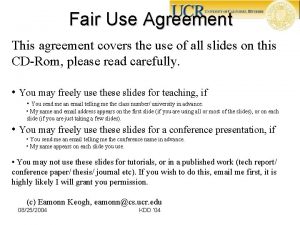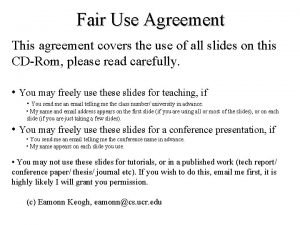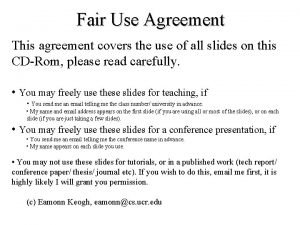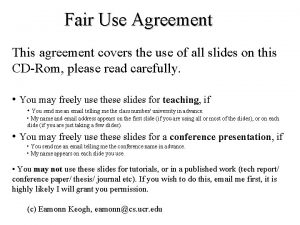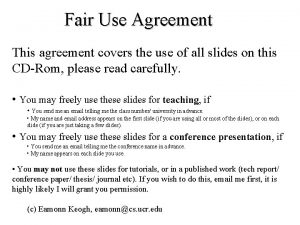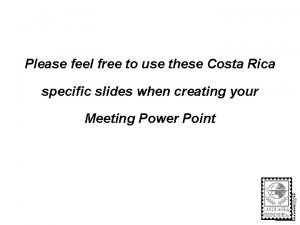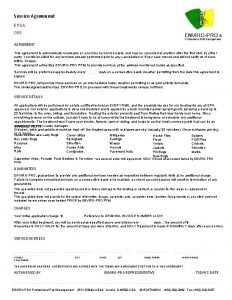Power Point Fair Use Agreement Please feel free






































- Slides: 38

Power. Point Fair Use Agreement • Please feel free to use this presentation with students or faculty members. • The pictures included in this presentation (with the exception of the Pearl Harbor photo) have all been taken by me, Ann Howden. • If you choose to use this presentation or any of the included photographs, YOU MUST give me credit for the work either by adding my name to the photographs or leaving my title slide on the show.

Photography Tips and Tricks Ann Howden UEN Professional Development ann@uen. org

To begin with • Photography is about telling a story. • Good photographers use an image to make a point without words. • People remember pictures of events long after they remember the actual event or the words that were spoken.

What event does this image portray?

What landmark is this?

What emotion is being displayed?

Thoughts about Yearbook Photography • The essence of a yearbook is it’s photography (80% is pictures). • People look at the pictures before they read the text. • Include EVERYONE !

…When on assignment… • Consider: – Distance from subject – Amount of light – Type of activity • The further away you have to be, the better camera you will need. (SLR vs. point and shoot) – Candid photos are always better than posed. • Capture emotion, expression and action.

Tip One: Use the Rule of Thirds • View your pictures as a grid and make sure that the subject of your picture is at one or more of the intersecting lines.





Tip Two: Look your subject in the eye • Take a photograph of a person, animal or object from it’s eye level, not yours. – This means get on the ground, get up high, and be constantly on the move with your subject.




Tip Three: Simplify your background • Keep your photo free of clutter. • Keep backgrounds simple and plain. • Avoid having extra people or subjects in your photo. • By keeping the background clean and simple, you create an automatic focal point for your picture.




Tip Four: Be a picture director • Avoid taking “snapshots”. • Direct your subject. • Create a theme. • Move objects around. • Remember that you are in charge of the photo.



Sometimes, being a picture director means you have your camera ready at all times…so that if you see a great shot, you have the chance to take the photo.

Tip Five: Alter your camera angle • Take vertical pictures. • Shoot holding your camera at an angle. • Get above and below your subject for effect. • Play with wide angle and zoom options.

This picture is okay, but could it be better to create a mood or an emotion?

• By altering your camera angle from horizontal to vertical, and by looking up at a specific section of a subject, you can really create an excellent composition.

Adding extra background or foreground to your photo is great for effect. Use the scenery to frame your shot.

When taking pictures of sporting events or school activities, remember to include the crowd, the participants, and the bench warmers. Everyone deserves to be remembered.

Tip Six: Play with the flash • Use the flash outdoors to correct for sun and shadows. • Don’t use the flash indoors…let the camera try harder to find the natural light. • Make sure you know the “flash range” of your camera – Stay within the camera range to take a good shot

Tip Seven: Move in close…then get closer • “Macro” photography is always appealing to the eye. • Close-up photographs are generally more interesting. • Make your subject fill the entire frame of your picture.




A few other thoughts about photography… • Be spontaneous • Take pictures of the unusual • Use your photographs to show memories, not just to document events • Be creative • Think before you shoot • Hold the camera steady (use a tripod when available)

General Camera Tips • Digital is easier and faster • Have a backup memory card for every event (precautionary) • 4 -6 megapixels is all you really need – Point and shoot vs. SLR • Have a good file management system • Back-up photos regularly • Avoid cropping as much as possible

Photography Tips and Tricks Ann Howden UEN Professional Development ann@uen. org
 Please feel free to use it
Please feel free to use it Feel free to edit
Feel free to edit If you have any questions please feel free to interrupt me
If you have any questions please feel free to interrupt me Feel free to call
Feel free to call Take out your notebook
Take out your notebook Root ject
Root ject Sonnets 14 lines
Sonnets 14 lines Foul is fair and fair is foul literary device
Foul is fair and fair is foul literary device Alliteration in macbeth
Alliteration in macbeth Fair is foul and foul is fair
Fair is foul and foul is fair Fair is foul and foul is fair literary device
Fair is foul and foul is fair literary device Fair play slide
Fair play slide Examples of fair is foul and foul is fair in macbeth
Examples of fair is foul and foul is fair in macbeth Affirmative and negative agreement
Affirmative and negative agreement Will you please be quiet please summary
Will you please be quiet please summary Free power point slide
Free power point slide Allppt.com _ free powerpoint templates, diagrams and charts
Allppt.com _ free powerpoint templates, diagrams and charts Power trianlge
Power trianlge Power bi power point
Power bi power point Point point power
Point point power Who sang i feel free
Who sang i feel free Training feel free
Training feel free Is free trade fair? discuss
Is free trade fair? discuss Is free trade fair? discuss
Is free trade fair? discuss New trade theory
New trade theory Fair trade not free trade
Fair trade not free trade Nafta
Nafta Fair use definition
Fair use definition Fair use
Fair use Fair use definition
Fair use definition Google images fair use
Google images fair use 4 factors of fair use
4 factors of fair use 4 factors of fair use
4 factors of fair use What property
What property Fair use in documentary
Fair use in documentary Common sense education fair and square
Common sense education fair and square Copyright basics for teachers
Copyright basics for teachers Welcome conference
Welcome conference Four factors of fair use
Four factors of fair use









































